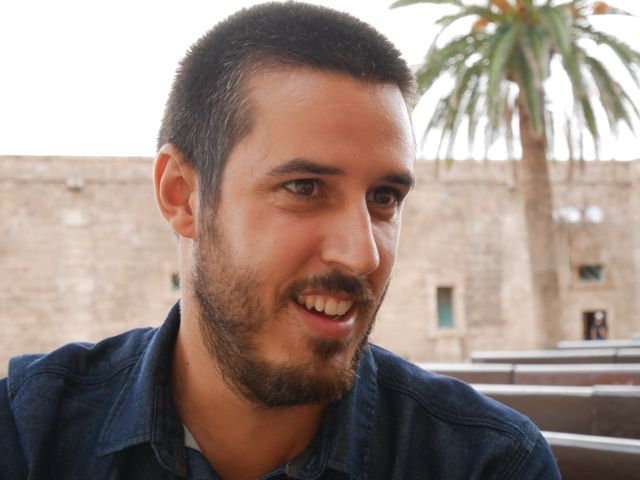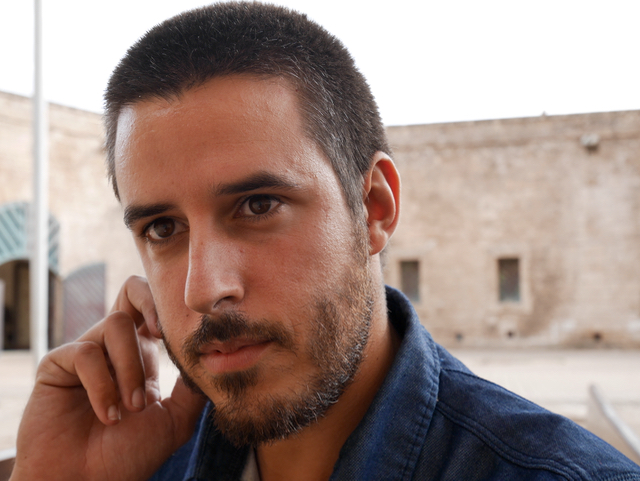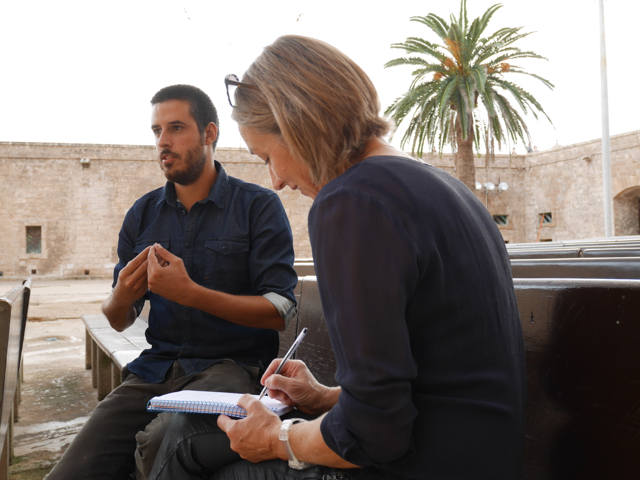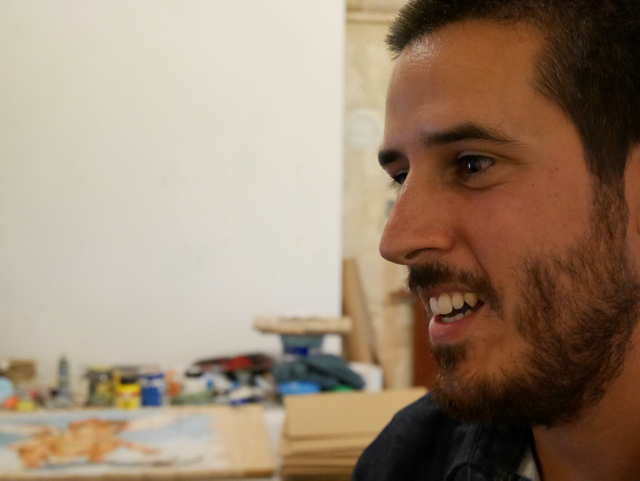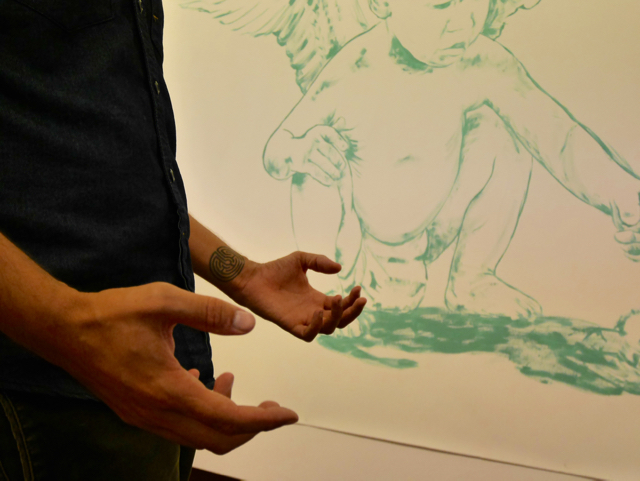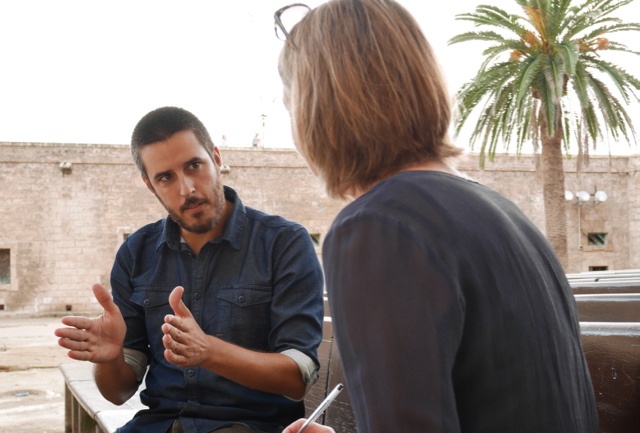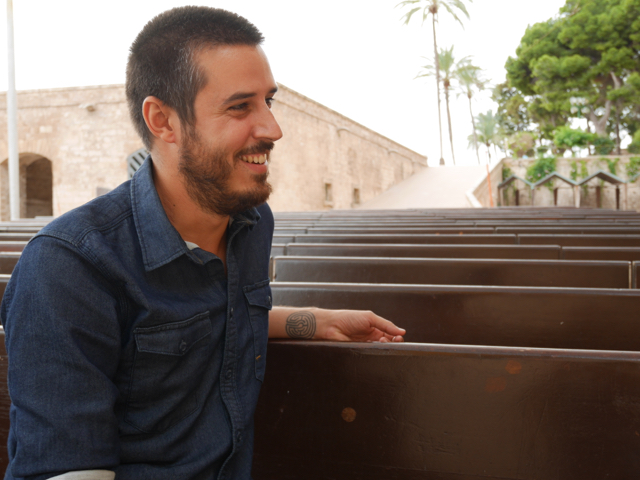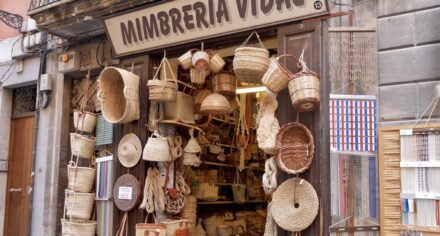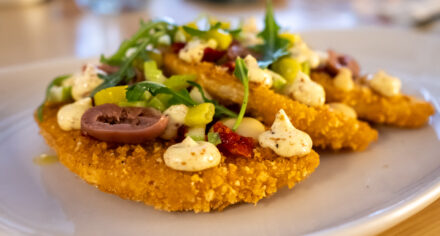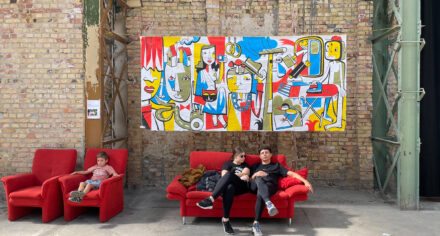Joan Aguiló about his way to become a street artist, finding places for his characters and what it’s like to paint in public.
We must have moved into Carrer Can Sans about the same time, the old couple and I. Whenever I pass their picture on the garage door opposite the Teatre Sans I mentally greet them. They look so happy and content with each other. He duit un rei al cos, says the line below, a quote from a Mallorcan sonnet which freely translates into something like ‚He is a king at heart’. It was my first encounter with Joan Aguiló’s street art, and soon I discovered more of his wonderful characters who populate Palma’s casco antiguo. I was curious to personally get to know the artist who created them and was happy when he spontaneously agreed to do an interview for my blog. We met at Ses Voltes, the city-owned studios near Parc de la Mar, where he had worked on several occasions. And I finally learned the story of my neighbors, the old couple.
1. What inspired you to become a street artist?
In the beginning, I have only been painting for galleries. But then, about four years ago, I spent a winter in Berlin where I organised street art tours. That was actually my first encounter with graffiti, and I knew that when I returned to Palma, I wanted to do something in the streets myself. Plus, I am very interested in Mallorcan people and culture, and I like to show my characters publicly. Meanwhile, my technique has become quite different, because I have entered this particular world of street art: it has it’s own capacity, it is quite territorial, and the people in the streets work very fast.
2. How do you find the places for your murals?
Sometimes I ask the proprietor, but mostly not. I love Palma’s historic city center, it has something magical. When you walk around with your friends you take your time and just discover the right spot – and often the places find me when I pass them. I respect the old facades a lot, and my work really grows within their atmosphere. Outside, it’s just you and the paint. You make a connection with the drawing that you don’t in other places, it’s completely different in a clean atmosphere.
Every once in a while, I’m trying to work outside of Mallorca, so I lived in Mexico for a while, and traveled to Madrid, Barcelona, and London – and hope to get back to Berlin, some day – but I always love to come back. I used to have a working room at my grandmother’s house in Sa Pobla, and I have been working here at Cac Ses Voltes, too, in a co-sharing workshop. It’s a good thing to work with other artists who share the same interests. But I needed longer working hours, so I’m happy to have my own studio on Carrer Sant Ferran in Palma, now.
3. Did people ever chase you away when you were painting in public places?
Well yes, occasionally. But if you take your time and explain your work, most people like what your’re doing. When I was painting the three old men at Placa Mercadal, the police passed me several times but they didn’t stop me from painting. If you paint during the day, it just never looks illegal.
Some characters are even adopted and taken care of by their neighbors, like the old couple on Carrer Can Sans, the grandparents of my former girlfriend. When her grandfather died, I painted that mural in memory of and as a gift to him. He was a wonderful man, I really liked him a lot. He and his wife loved to go to Can Joan de s’Aigo, and everybody there knew them. So, of course the mural had to be near the chocolateria, and now, when the picture is damaged in some way, the people from Can Joan fix it.
4. You have been working as a teacher for arts, theater, technology and computer sciences at Pedro Poveda, a comprehensive school in Palma. Why did you stop teaching?
I really loved to work with the kids, and they liked to go out with me and discuss my paintings. But I needed more time to paint, I have a lot of ideas and ongoing projects. Today, I can live from my art, and that’s what I want in my life. One thing I would really love to do is a street art festival in Can Picafort. It’s a not so nice village, but when I was a kid I spent all my summers there, so it has always been special to me. This is why I want to contribute to the festival, to make the village a nicer place for others, too.
5. You were born on Mallorca and you have been living here most of your life, what is your favorite place on the island?
There is a natural cave between Santa Maria and Orient called Avenc de Son Pou. It’s a giant dome with strange dripstones and a hole in the ceiling that permits daylight to get in. For me, this is definitely one of the most beautiful places on Mallorca. ![]()

